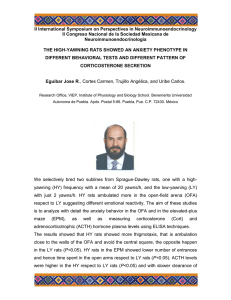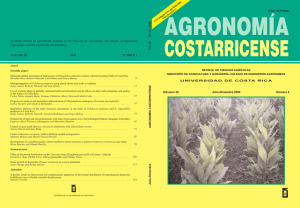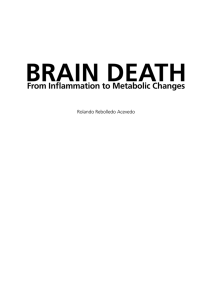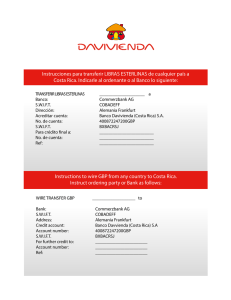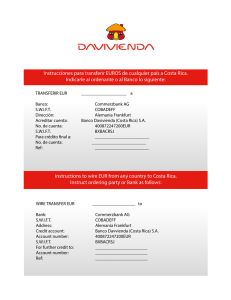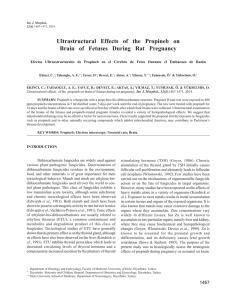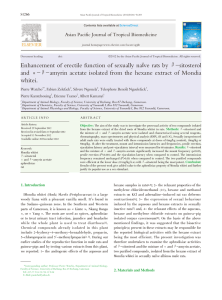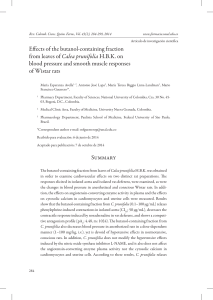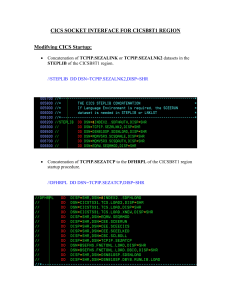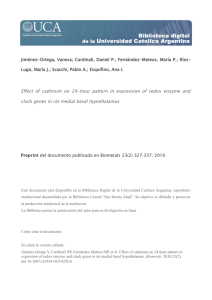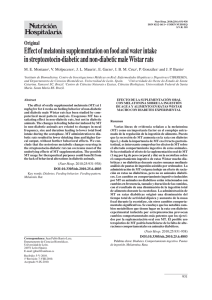Antihypertensive effect of Cecropia obtusifolia
Anuncio
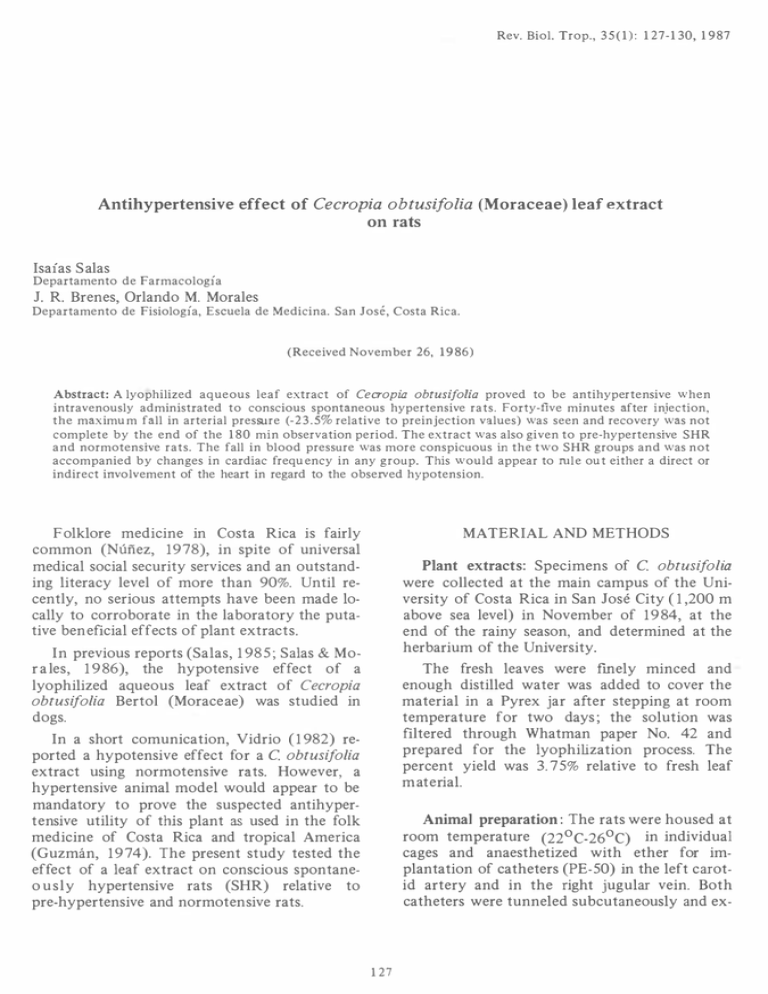
Rev. Biol. Trop., 3 5 ( 1 ) : 1 27-1 30, 1 987 Antihypertensive effect of Cecropia obtusifolia (Moraceae) leaf extract on rats Isaías Salas Departamento de Farmacología J. R. Brenes, Orlando M. Morales Departamento de Fisiología, Escuela de Medicina. San José, Costa Rica. (Received November 26, 1 9 86) Abstract: A lyophilized aqueous leaf extract of Cecropia obtusifolia proved to be antihypertensive when intravenously administrated to conscious spontaneous hypertensive rats. Forty-frve minutes after injection, the maximu m fall in arterial pressure (-2 3 . 5% relative to preinjection values) was seen and recovery was not complete by the end of the 1 80 min observation periodo The extract was also given to pre-hypertensive SHR and normotensive rats. The fall in blood pressure was more conspicuous in the two SHR groups and was not accompanied by changes in cardiac frequ ency in any group. This would appear to rule ou t either a direct or indirect involvement of the heart in regard to the observed hypotension. MATERIAL AND METHODS Folklore medicine in Costa Rica is fairly common (Núñez, 1978), in spite of universal medical social security services and an outstand­ ing literacy level of more than 90%. Until re­ cently, no serious attempts have been made lo­ cally to corroborate in the laboratory the puta­ tive beneficial effects of plant extracts. Plant extracts: Specimens of e obtusifolia were collected at the main campus of the Uni­ versity of Costa Rica in San José City ( 1 ,200 m aboye sea level) in November of 1 9 84, at the end of the rainy season, and determined at the herbarium of the University. In previous reports (Salas, 1 98 5 ; Salas & Mo­ r a les, 1 9 86), the hypotensive effect of a lyophilized aqueous leaf extract of Cecropia obtusifolia Bertol (Moraceae) was studied in dogs. The fresh leaves were fmely minced and enough distilled water was added to cover the material in a Pyrex jar after stepping at room temperature for two days ; the solution was filtered through Whatman paper No. 42 and prepared for the lyophilization process. The percent yield was 3. 75% relative to fresh leaf material. In a short comunication, Vidrio ( 1 982) re­ ported a hypotensive effect for a e obtusifolia extract using normotensive rats. However, a hypertensive animal model would appear to be mandatory to prove the suspected antihyper­ tensive utility of this plant as used in the folk medicine of Costa Rica and tropical America (Guzmán, 1 9 74). The present study tested the effect of a leaf extract on conscious spontane­ o u sly hypertensive rats (SHR) relative to pre-hypertensive and normotensive rats. Animal preparation : The rats were housed at room temperature (22 0 C-260 C) in individual cages and anaesthetized with ether for im­ plantation of catheters (PE-50) in the left carot­ id artery and in the right jugular vein. Both catheters were tunneled subcutaneously and ex- 1 27 REVISTA D E B IOLOGIA TROPICAL 128 TABLE 1 An tihypertensive effeet of C. obtusifolia extraet on unanaesthetized spontameously hypertensive rats Mean arterial pressure ± SEM (mmHg) Groupl N Preinjection Control + 15 + 30 + 45 + 60 + 1 20 + 1 80 min SHR 10 1 6 1 . 5 ± 3.3 1 46 . 5 ± 9 . 6 1 30 . 5 ± ? ? 1 2 3 . 5 ± 8.4 1 28.0 ± 1 0. 0 1 32.5 ± ? ? 1 40.0 ± 6 . 1 8 1 2 8 . 1 ± 4.2 1 15.6 ± 5 . 2 1 1 3. 8 ± 4.4 1 1 3.6 ± 5.9 1 0 4.4 ± 5 . 0 103. 1 ± 6.3 1 2 2.5 ± 5 . 1 10 1 1 9.5 ± 5.3 1 1 8.4 ± ? 9 1 20.0 ± 4. ? 1 1 3.5 ± 5.1 1 1 1 .0 ± 5 . 1 1 1 6.0 ± 3 . 9 1 1 8.0 ± 4. 3 P-SHR NOR I S � R : Spont � neously hypertensive rats. P-SHR: Pre- Spontaneously hypertensive rats'' and NOR'. Normal rats. All ammals recelved a single bolus Lv. injection (50 mg/kg) of the extracto teriorized in the back of the animal. Mean and pulsatile arterial pressure were continuously monitored by use of a pressure transducer ( m o d e l R P - 1 5 0 0 i ) , conne cted t o a H ewlett-Packard polygraph (Model 7754A). Heart rate was measured from the peak pulse pressure of the recording. Three groups of rats were used, according to the fol lowing criteria : ( i) adult (269 ± 6 . 8 g; mean ± SEM) , spontaneous hypertensive (SHR) animals of the Okamoto-Aoki Strain with mean arterial blood pressure (MAP) higher than 1 50 mmHg; (h) p rehypertensive (P-SHR) rats as re­ presented by younger ( 205 ± 7 . 3 g) SHR ani­ mals with MAP less 1 50 mmHg; and (iii) normotensive (NOR) albino rats ( 243 ± 6.4 g) of the Sp rague-Dawley strain. All the animals were fe � a locally produced rat chow (Cartago, Costa RIca) and tap water ad libitum and were reared at the biotery of the Unive rsity of Costa Rica, with 1 3 hours light and 1 1 hours darkness cycles. Surgery was performed in the morning and the control MAP recording wa s obtained in the afternoon of the same day. Fifty mg/kg of the extract was then administered intravenously in isotonic saline 0.9% (OA mI/min) by infusion using a Gilford pump (Model 1 0 5 S). D u r i n g t he e x periment the rats were conscious and allowed to rest freely in the cage. A dose of 50 mg/kg was chosen, because it gave a marked and yet non-lethal effect, according to previously documented dos e response curve data. The MAP response was recorded for three hours. After pooling the data, the results were expressed as the mean value ± the standard error of the mean (X ± SEM) . Significance of means was tested using ANOVA followe d by Tukey's analysis. RESULTS The intravenous infusion of lyophilized ex­ tracts of C. obtusifolia on SHR caused a de­ crease in MAP of 23. 5% (Table 1 ) . The hy­ potensive response was apparent a few minutes after administration and reached maximum effect 45 minutes later. Three hours later the MAP still had not retumed to the pre-inje ¿tion level (F ig. 1 ) . A t all times, except 1 5 minutes after the injection of the extract, the MAP showed significant differences as compared with the preinjection value (P < 0. 0 1 ) . When the same dose was administered to the P-SHR group, the response followe d the same trend as the SHR group, but the ' hypotension was less profound and the maximum fall was delayed in time (60- 1 20 minutes). A nearly complete re­ covery was seen by the end of the recording period (Fig. 1 ) . The response of the NOR rats was close to that of the P-SHR group, with no significant differences between them. 1t is inter­ esting to note that the acu te fall in the MAP appeared to be dependent upon the level of the preinjection pressure,i.e. , the anti-hypertensive effect was more evident in the group with higher blood pressure. With regard to the cardiac frequency, the control values in the three groups were statisti­ cally different . Nevertheless, the cardiac fre­ quency after extract injection remained un­ changed for all three groups when subjected to statistical analysis (Table 2). SALAS et al. : Antihypertensive effect of Cecropia obtusifolia SHR 5 P - SHR NOR O 1 29 0--­ 01---­ 6--- -5 � ....., a. « ::::E -10 w (!) z « :I: (J -15 � -20 -25 -30 1----,---.---,---,r15 30 45 o 60 75 90 1 05 120 1 35 1 50 1 65 1 80 TIME (min) Fig. l . Temporal evolution of the MAP on conscious hypertensive, pre-hypertensive and normotensive rats, acu tely treated with Lv. extract of C. obtusifolia. SHR: spontaneous hypertensive rats ; P-SHR: prehypertensive rats and, NOR : normotensive rats. TABLE 2 Effect of C. obtusifolia extraet on eardiae frequency Cardiac frequency ± SEM (beatsfmin) Preinjection Groupl N. 45 30 15 Control 60 1 20 1 80 SHR 6 360.0 ± 10.7 364.5 ± 8.6 35 8.0 ± 9.3 360.0 ± 9.9 366.0 ± 8.2 366.0 ± 7.2 364.5 ± 8.3 P-SHR 8 3 30.0 ± 1 6.5 332.7 ± 1 4. 2 353.7 ± 22.9 344.0 ± 20.2 3 39.7 ± 22.4 323.2 ± 20.6 3 30 . 7 ± 15.6 10 292.6 ± 1 8.4 288.2 ± 22.5 296.6 ± 1 8. 2 274.0 ± 1 7. 3 279.0 ± 1 4.4 270.0 ± 1 8. 9 285 . 1 ± 1 9.4 NOR 1 SHR: Spontaneously hypertensive rats; -SHR: Pre spontaneously hypertensive rats; and NOR: Normal. AH animals receveid a single i.v. injection of C. DISCUSSION In recent reports of natural products re­ search, plant extracts with hypotensive effects are rather common (Ojewole, 1981 ; Ammon, 1 985). In our case, in two groups of experimen­ tal animals tested, a antihypertensive effect was found and the lowering of blood pressure appeared to be proportional to the pre-injection obtusifo/ia of 50 mgfkg. pressure leve!. In the normotensive group, even though sorne hypotension was present, the fal! was not significant. No attempts were made to clarify the site or mechanism of action of the extract, but the data suggest a possible block­ ade of the baroreceptor response. No change in cardiac frequency was observed in the three ex­ perimental groups at any time after injection. In dogs, three mechanisms for the hypotension REVIST A DE BIOLOGIA TROPICAL 1 30 have been proposed in dogs: ganglionic block­ ade , decreased inotropism and bradycardia (Sa­ las, 1 985; Salas and Morales, 1986). It is worthy to note that, contrary to other investigators (Vidrio, 1982) , we could not de­ tect significant changes in blood pressure or car­ diac frequency in normotensive rats; however our methods were quite different with regard to the ey.tract preparation, doses used and animal model. The main contribution of this paper is that the active anti-hypertensive principIe of C. ab­ tusifalia exe rts its maximum effect without bradycardia and that SHR animals seem more sensitive to its effects than normotensive ani­ mals. la inyección. El extracto se administró por infu­ sión a tres grupos de animales: hipertensos, pre­ hipertensos (SHR) y a normotensos (Sprague Dawley). La disnúnución de la presión arterial fue más evidente en el grupo de ratas hiperten­ sas, siendo estadísticamente significativa en re­ lación a los otros dos grupos (p , 0.05) de acuer­ do con el ANOVA y análisis por el método de Tukey. Esta disnúnución de la presión arterial media (PAM) no fue acompañada por variaciones de la frecuencia cardiaca en ningún grupo, lo cual in­ dica que no hay participación del nodo sinusal directa o indirectamente en la hipotensión ob­ servada. REFERENCES ACKNOWLEDGEMENTS This investigation has been supported by a research grant from the Research Council of the Universidad de Costa Rica, project No. 422 -84 -045. The extraction process done at CIPRONA (Centro de Investigación de Productos Natura­ les) is also acknowledged. We thank L. F ournier of the Department of Biology for the taxonom­ ic identification of the planto RESUMEN El extracto crudo liofilizado de Cecrapia ab­ tusifalia administrado intravenosamente a ratas espontáneamente hipertensas (SHR), no aneste­ siadas ( 50 mgjkg de peso), mostró poseer pro­ piedades antihipertensivas. La presión arterial disminuyó a un mínimo nivel (76 .4%) del valor control ( 1 6 1 . 5 mmHg), 45 minutos después de Ammon, H.P.T. 1 9 85, Forskolini: from an Ayuverdic remedy to a moderm agent. Plant. Med. 5 1 : 473-477. Guzmán, D. 1 974. Cecropia pe/tata. Especies útiles de la flora salvadoreña. Editorial Ministerio de Educa­ ción. El Salvador, p. 92-94. Ojewole, J . A. 1 9 8 1 . Mechanism of the hypotensive effect of tetramethylpyrazine an amide alkaloid from the stem of Jatropha podagrica. Plant. Med. 4 1 : 281- 7. Salas, LG. 1 985. Mecanismo de acción cardiovascular de los extractos frescos liofilizados de Cecropia ob­ tusifo/ia. Berto!. Tesis de Maestría, Universidad de Costa Rica, San José, Costa Rica. Salas, L & O. M. Morales. 1 986. Hypotensive effect and site of action of lyophilized extract of Cecro­ pia obtusifo/ia. Plant. Med. (in press). Vidrio, H. 1 982. Hypotensive Activity of Cecropia ob­ tusifo/ia. J. Pharm. Sci. 7 1 : 475-476 .
